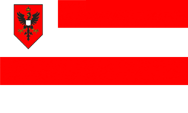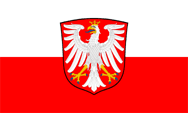The flag of the Free City of Frankfurt showed four horizontal stripes in red and white (the colors of the city) and in a white upper corner the coat of arms of the city. It shows a white eagle on a red background. The eagle, the symbol of the German Empire is reminiscent of Frankfurt as a "free and imperial city". In 1866 Frankfurt became annexed to the Prussian province of Hesse-Nassau, which was reflected in the adoption of the new flag. It shows up to now two horizontal stripes in white and red and the coat of arms of the city in the middle.
Source: Volker Preuß


to 1815(?), Cockade of Frankfurt,
Source: Jürgen Kaltschmitt → H.u.R.Knötel/H.Sieg, "Farbiges Handbuch der Uniformkunde", sincee 108

from 1815(?), Cockade of Frankfurt,
Source: Jürgen Kaltschmitt → H.u.R.Knötel/H.Sieg, "Farbiges Handbuch der Uniformkunde", sincee 108

read here:
Informations, history and facts about the theme "Cockades".

Cockade


The map shows Frankfurt (yellow) at the time of the Thirty Years' War, in the middle, between the counties of Isenburg (pale red) and Hanau (green).
Source: Professor G. Droysens Allgemeiner Historischer Handatlas

Area: ca. 77 square miles (1866)
Inhabitants: 92.200 (1864)
Currency: 1 Gulden = 60 Kreuzer = 240 Heller
Source: HGISG Geoinform,
Wikipedia (D)

originally a Roman fort, later royal palace
794 · first mentioned
1372 · Free Imperial City
from 1356 · place of the election of the German kings
1562 · place the crowning of the German Emperors
1533 · Reformation
1806 · seat of the Primate of the Rhine Confederation
1810–1813 · Grand Duchy of Frankfurt
1815–1866 · member of the German Confederation
1866 · after the German war annexed by Prussia
1945 · to the newly created state of Hesse
Source: Discovery '97,
Wikipedia (D)

The name of the city goes back to a flat place on the River Main, the ford of the Franks.
Source: Handbuch der geographischen Namen







![]()











